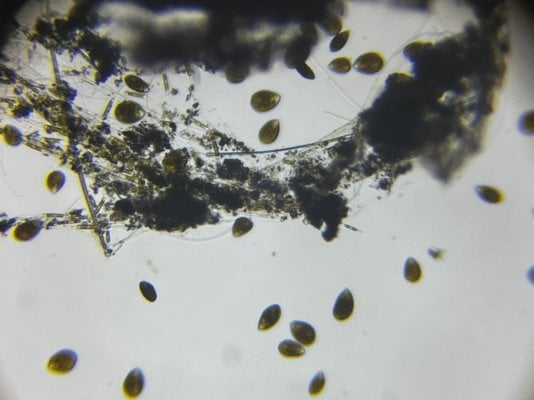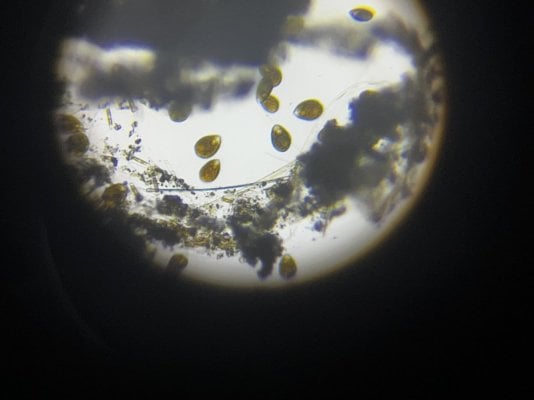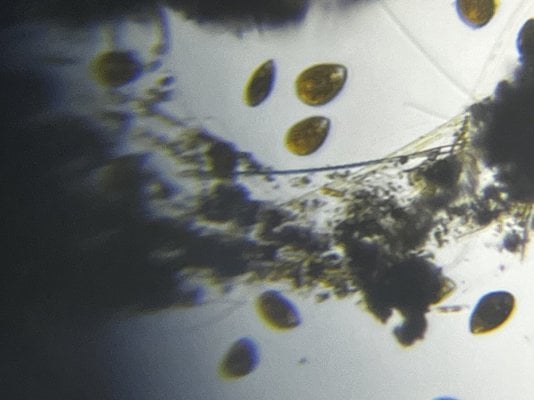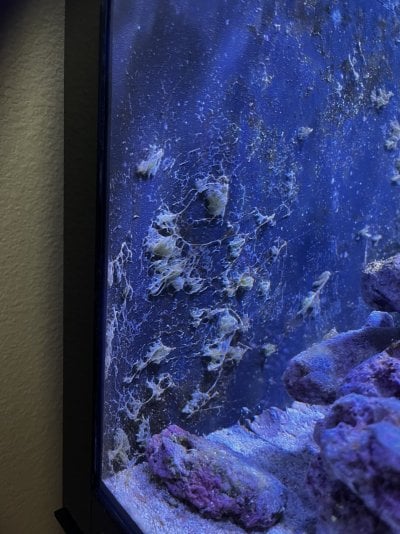No corals bleached or died before the outbreak. Lighting is a kessil A360we. ran 40% on peak intensity on the light schedule.Did any corals bleach or die before the Dino outbreak? What’s your lighting?
Navigation
Install the app
How to install the app on iOS
Follow along with the video below to see how to install our site as a web app on your home screen.
Note: This feature may not be available in some browsers.
More options
You are using an out of date browser. It may not display this or other websites correctly.
You should upgrade or use an alternative browser.
You should upgrade or use an alternative browser.
Dinoflagellates – Are You Tired Of Battling Altogether?
- Thread starter mcarroll
- Start date
- Tagged users None
- Joined
- Jul 16, 2018
- Messages
- 256
- Reaction score
- 194
I started my current tank with the same method I ran my past aquariums. Dry rock, caribsea sand, about a 6 week cycle (ammonia and bacteria dosing) and then started stocking with fish and coral slowly. Like every new tank there was a ugly stage that eventually passes. This time around about 5-6 months in, microscope confirm porocentrum dinoflagellates.
My routine is feed fish every other day, feed corals twice a week (broadcast or target feeding), bi weekly 10% water changes. just like I've always done it in the pass with success.
Water testing done weekly. Parameters were in check nothing out of range I would say. pretty consistent nitrates of 5ppm, alk 9dkh, calcium 430, Ph 7.8, phosphates 0.05-0.03.
Not sure what is causing the Dinos.
Just out of curiosity what brand 2 part or what method are you using to keep water parameters stable?
tank was fairly new, one had a few pieces of coral. Water changes alone were maintaining parameters.Just out of curiosity what brand 2 part or what method are you using to keep water parameters stable?
But i usually use 2 part b- ionic when it comes time to dose.
hi guys,
Would you mind helping me with the positive ID? Is it ostreo?
had to replace the aiptasia ridden egg crates in my 1 yo frag tank (disturbed biome) and also didnt notice quick enough that my di resin needed to be replaced which i think leaked a bit of silicates via top offs.
As a result i have some white fuzzy stuff started growing on my frag plugs (another issue likely crysophites ), and started getting this brown bubbly stuff on new egg crates and over my zoas mostly.
SPS so far is ok, but my zoas are not enjoying life right now.
Would you mind helping me with the positive ID? Is it ostreo?
had to replace the aiptasia ridden egg crates in my 1 yo frag tank (disturbed biome) and also didnt notice quick enough that my di resin needed to be replaced which i think leaked a bit of silicates via top offs.
As a result i have some white fuzzy stuff started growing on my frag plugs (another issue likely crysophites ), and started getting this brown bubbly stuff on new egg crates and over my zoas mostly.
SPS so far is ok, but my zoas are not enjoying life right now.
- Joined
- May 22, 2016
- Messages
- 6,970
- Reaction score
- 10,747
for sure.hi guys,
Would you mind helping me with the positive ID? Is it ostreo?
Just thought I would give a quick update, and my story, thanks to this fellow reefer hoping im on the right track.Looks like large cell amphidinium to me. The small one is probably ostreo but too small to see. Dose silicates. Make sure you do not have elevated iron. Elevate nitrate and po4. Do not disturb the sand bed. Be prepared to continue like that for months until you see no more LCA on the scope. Good luck brother.
So i purchased a new trigon 350 about a year ago, i decided to have my first saltwater aquarium but do it on a less technical approach.
Im not using any skimmers etc, all im using is the internal filter that the aquarium came with, plus a couple of power heads, crushed coral and rock scape.
Anyway I always stuck to a stricked 10% weekly water change and 2 part dosed.
Nitrates always stayed at 2.5, and phosphates at 0.05 even with heavy feeding.
No one could believe i could keep these parameters at these levels with no extra help.
I currently have
2 clowns
Regal tang
Sailfin tang
Powder blue
Royal gramma
4 Cardinals
3 green chroma
So corals have always seemed to be slowly dieing after around 3 months, i also started getting this horrible brown stringy stuff everywhere, also having to clean glass every day as was getting covered in brown dust.
Anyway thanks to this reefer for identifying my dinoflagellates, I dosed my nitrates to 15 and phosphates to around 0.15 as suggested, after only a day I thought I started noticing some dinos decreasing. I decided to do the suggested black out, only did a 2 day black out with no feeding as i chickened out. After turning my lights on Wednesday, i was shocked to see 90% all brown had gone, by the evening my torch corals that looked like they was on there death bed are extending 50% more than they had been and more every day now.
Still now on day 3 and no more dinos and I haven't touched my glass as its crystal clear!!
Who would've thought you need a dirtier tank to have a cleaner tank! And to feed your corals!
Only wish I asked sooner before I lost my new york knicks torch's . ...
I did alot of research before I started and nearly all sites recommended all the levels i had. Inc
Salinity 35
calc 450
mag 1350
ph 8.1
alk 8.6
Anyway I hope this progress continues and may assist another struggling newbe like me. thanks again @Moe K
What type of dinos did you have?Just thought I would give a quick update, and my story, thanks to this fellow reefer hoping im on the right track.
So i purchased a new trigon 350 about a year ago, i decided to have my first saltwater aquarium but do it on a less technical approach.
Im not using any skimmers etc, all im using is the internal filter that the aquarium came with, plus a couple of power heads, crushed coral and rock scape.
Anyway I always stuck to a stricked 10% weekly water change and 2 part dosed.
Nitrates always stayed at 2.5, and phosphates at 0.05 even with heavy feeding.
No one could believe i could keep these parameters at these levels with no extra help.
I currently have
2 clowns
Regal tang
Sailfin tang
Powder blue
Royal gramma
4 Cardinals
3 green chroma
So corals have always seemed to be slowly dieing after around 3 months, i also started getting this horrible brown stringy stuff everywhere, also having to clean glass every day as was getting covered in brown dust.
Anyway thanks to this reefer for identifying my dinoflagellates, I dosed my nitrates to 15 and phosphates to around 0.15 as suggested, after only a day I thought I started noticing some dinos decreasing. I decided to do the suggested black out, only did a 2 day black out with no feeding as i chickened out. After turning my lights on Wednesday, i was shocked to see 90% all brown had gone, by the evening my torch corals that looked like they was on there death bed are extending 50% more than they had been and more every day now.
Still now on day 3 and no more dinos and I haven't touched my glass as its crystal clear!!
Who would've thought you need a dirtier tank to have a cleaner tank! And to feed your corals!
Only wish I asked sooner before I lost my new york knicks torch's . ...
I did alot of research before I started and nearly all sites recommended all the levels i had. Inc
Salinity 35
calc 450
mag 1350
ph 8.1
alk 8.6
Anyway I hope this progress continues and may assist another struggling newbe like me. thanks again @Moe K
I posted videos on the previous page,
I have spoken to a few people now and all have said people with higher nutrients rarely get dinos
I posted a video on the previpage, it was suggested i had LCA but obviously this may not be accurate, all I know is the advice given worked.What type of dinos did you have?
I have spoken to a few people now and all have said people with higher nutrients rarely get dinos
After a very long and hard fought battle with high phosphates in my 9 year old system, I over-shot my target and they bottomed out. I have quickly raised them back up to 0.1 ppm (actually overshot that too and currently at 0.5 ppm PO4). Nitrate is at 10 ppm and stable. I have dinos on a single side of my tank that I don't scrape as often as the other sides because it is against a wall (partially against an exterior window). They look like small cell Amphidinium to me, but maybe that is wishful thinking. What do you all think?
Sorry the microscope images are not the best, but I think the video shows how fast they move which led me to think they are the small cell amphidinium.
Tank wall appearance:

400x photo:

Video 400x:
Sorry the microscope images are not the best, but I think the video shows how fast they move which led me to think they are the small cell amphidinium.
Tank wall appearance:
400x photo:
Video 400x:
- Joined
- May 22, 2016
- Messages
- 6,970
- Reaction score
- 10,747
This is a cryptomonas / rhodomonas. Not actually dino. Big population though!They look like small cell Amphidinium to me, but maybe that is wishful thinking. What do you all think?
These are not a dino. They are another random harmless flagellate. Something like a cryptomonas / rhodomonas.
Here they are in a couple of vids from my system, shape and movement a lot like yours:
(Close-up):
Well thats a huge relief. Now how do I cancel that $300 ebay offer on a 57w aqua UV…This is a cryptomonas / rhodomonas. Not actually dino. Big population though!
- Joined
- May 22, 2016
- Messages
- 6,970
- Reaction score
- 10,747
Heh, or watch this thread for potential people to re-sell to.Well thats a huge relief. Now how do I cancel that $300 ebay offer on a 57w aqua UV…
I suppose this, which I’m also culturing inches away from my fuge, is likely the source of such a large population. Guess I can stop dosing it…

That's really cool if they are actively growing in your tank.I suppose this, which I’m also culturing inches away from my fuge, is likely the source of such a large population. Guess I can stop dosing it…
Ya, I don’t know how it happened but I have to say I’m quite proud now haha. I think I’m going to leave that glass un-scraped and just make it a permanent phyto supply for the tank. I wish I knew how it happened because I’m sure a lot of folks would like to have a never-ending supply of coral food growing in their tank…That's really cool if they are actively growing in your tank.
After a very long and hard fought battle with high phosphates in my 9 year old system, I over-shot my target and they bottomed out. I have quickly raised them back up to 0.1 ppm (actually overshot that too and currently at 0.5 ppm PO4). Nitrate is at 10 ppm and stable. I have dinos on a single side of my tank that I don't scrape as often as the other sides because it is against a wall (partially against an exterior window). They look like small cell Amphidinium to me, but maybe that is wishful thinking. What do you all think?
Sorry the microscope images are not the best, but I think the video shows how fast they move which led me to think they are the small cell amphidinium.
Tank wall appearance:

400x photo:

Video 400x:
that's a perfect sample picture with the tank example and the youtube video is great!! I'd like to have the video for a screen saver lol$$
good luck with your battle, the end is coming!
Welp, I think I got Dinos. Tank is 6 months old and mix reef mostly SPS. Acans and Goniporas seem irritated but the rest of my corals are fine. The Dino is mostly growing on my powerheads, overflow area and back glass. Don’t really see any on my rocks or sand. I noticed it popped up after a 30% water change one day and I had siphoned my sump of most of the detritus. My tank has always had undetectable nutrient levels since after the cycle. I’ve been growing chaeto and pulsing Xenia in my refugium area very early on. This is my first run in with Dinos, so I’ll report back if I beat it.

Got a bad case of prorocentum dinos after a treatment for cyano. My nutrients are really high. Nitrates at 35 and phosphates at 0.8.
I have been adding bacterias, phyto, and silicate for two weeks, I have UV always on, but the dinos are only getting worse, they are everywhere and some of the corals started to get bothered by it. So yesterday I started a 3 days blackout, hopefully that fixes it.
I have been adding bacterias, phyto, and silicate for two weeks, I have UV always on, but the dinos are only getting worse, they are everywhere and some of the corals started to get bothered by it. So yesterday I started a 3 days blackout, hopefully that fixes it.
Last edited:
putting all my fish, critters & corals in quarantine and killing the lights, flow, and heat for a week seems to have killed off a stubborn case of dinos in my 55g. added 5kg of fresh liverock, dosed bacteria & pods, & did a 20% water change when i turned everything back on, and let everything settle for another week before adding the livestock back. so far no dinos. the temp dropped to 16-18C when i had the heat off. this also melted 95% of the hair algae on my rocks, i had to suck it out through a filter sock.
Need some help with ID. Trying to get more steady clear pictures…
Only visible in display, sump has some tbs live rock. Nutrients pretty low .02 P04 and around 5 tank is pretty young.




Update: Got feedback and recommendations from a FB group as
Ostreopsis, which are toxic but can be easily treated with UV and activated Carbon.
Only visible in display, sump has some tbs live rock. Nutrients pretty low .02 P04 and around 5 tank is pretty young.




Update: Got feedback and recommendations from a FB group as
Ostreopsis, which are toxic but can be easily treated with UV and activated Carbon.
Last edited:
Similar threads
- Replies
- 43
- Views
- 539
- Replies
- 1
- Views
- 88
- Replies
- 4
- Views
- 251




















